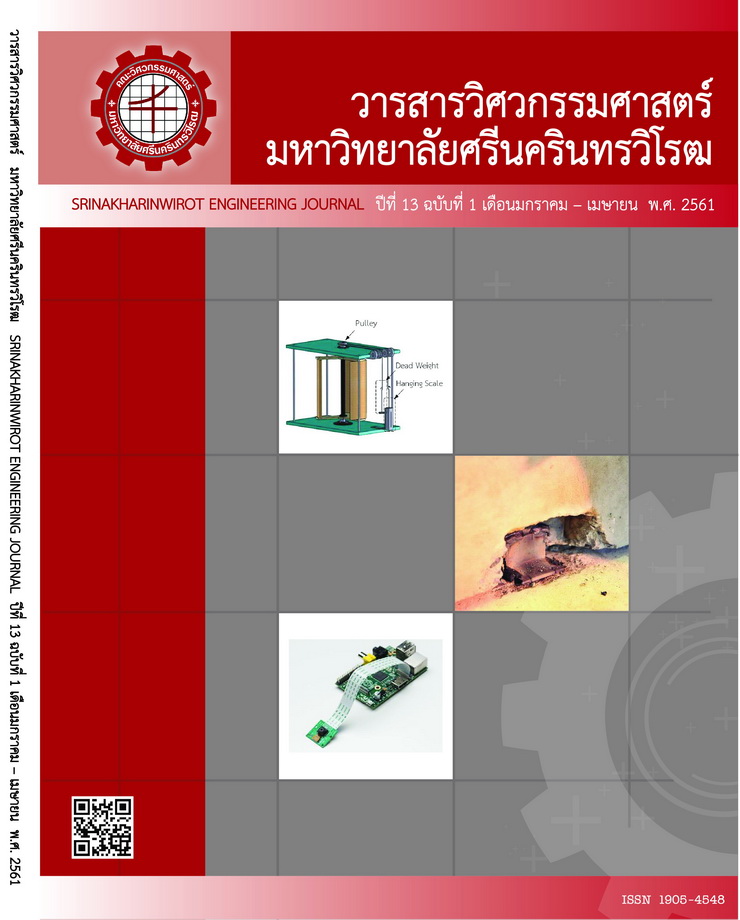Defect Reduction in Film Blowing Process by Six Sigma Approach
Main Article Content
Abstract
This research aims to reduce waste from the production of defects which are gel or dark specks, wrinkle and uneven thinness defect along Transverse Direction (TD) of machine that occur in film blowing process. The research applied Six Sigma methodology which composed for five phases. Phase I : Define phase, it was found the waste from plastic bags of size 30 x (6 + 2 + 2) inches had the defective rate due to these three defects totaling 11.03 percent of the production volume. Phase II : Measures phase, the accuracy precision of the inspection system were analyzed and found that it was acceptable. Phase III : Analyze phase, 22 potential factors affecting these defects were listed by using brainstorming technique and Fishbone diagram. Next 9 factors were selected to be studied further using the Cause and Effect matrix. Phase IV : Improvement phase, two improvement approaches were performed. First, the design of experiments technique was applied to prove for significance of factors and find the optimal setting. Second, quality procedure and work instructors were created. Phase V : Control phase, confirmatory experiment was performed and control plan was set up to maintain the quality level after improvement. The factors, which affect these defect are temperature control, production speed, and condition of machine. After improvement, the defective rate due to these defects was reduced from 11.03 percent to 0.39 percent, which equivalent to a reduction of 99 percent. The improvement leads to the loss saving of 68,527 baht per year for the model under study.
Article Details
Copyright belongs to Srinakharinwirot University Engineering Journal
References
[2] ไพโรจน์ บาลัน, การจัดการกระบวนการตามหลัก Six Sigma. กรุงเทพมหานคร: อีไอแสควร์พับลิซซิ่ง, 2549.
[3] เจริญ นาคะสรรค์, กระบวนการแปรรูปพลาสติก. กรุงเทพมหานคร: สำนักพิมพ์นิติธรรม, 2547.
[4] G. Hiesgen, K. Saul, and C. Rauwendaal, “Temperature induced dimensional variation in extrusion,” in The Regional Conference Graz 2015 – Polymer Processing Society PPS, Graz, Austria, 2015, pp. 030005.
[5] C. Rauwendaal, “Effective troubleshooting of extrusion problems,” in The Regional Conference Graz 2015 – Polymer Processing Society PPS, Graz, Austria, 2015, pp. 030021.
[6] J. Sung Lee, D. M. Shin, H. S. Song, H. Wook Jung and J. Chun Hyun, “Existence of optimal cooling conditions in the film blowing process,” J. Non-Newtonian Fluid Mech., vol. 137, pp. 24-30, Aug. 2006.
[7] J. G. Khan, R. S. Dalu and S. S. Gadekar, “Defects in extrusion process and their impact on product quality,” Inter. J. Mech. Eng. Robot. Res., vol. 187, pp. 187-194, Jul. 2014.
[8] K. S. Yoon and C. W. Park, “Stability of a blown film extrusion process,” Int. Polym. Proc., vol. 14, pp. 342-349, Dec. 1999.
[9] J. S. Lee, I. Kwon, H. W. Jung, and J. C. Hyun, “Helical instability in film blowing process: Analogy to buckling instability,” Phys. Fluids, vol. 29, p. 121501, Dec. 2017.
[10] J. Peng, K. Wei and W. Lui, “Response surface optimization of the feed compositions of biodegradable packaging foams,” Packaging Technol. Sci., vol. 18, pp. 321-330, Sep. 2005.
[11] D. C. Montgomery, Design and analysis of experiments, 8th ed. Hoboken, NJ: John Wiley & Sons, 2005.
[12] ปารเมศ ชุติมา, การออกแบบการทดลองทางวิศวกรรม” กรุงเทพมหานคร: สำนักพิมพ์แห่งจุฬาลงกรณ์มหาวิทยาลัย, 2545.


